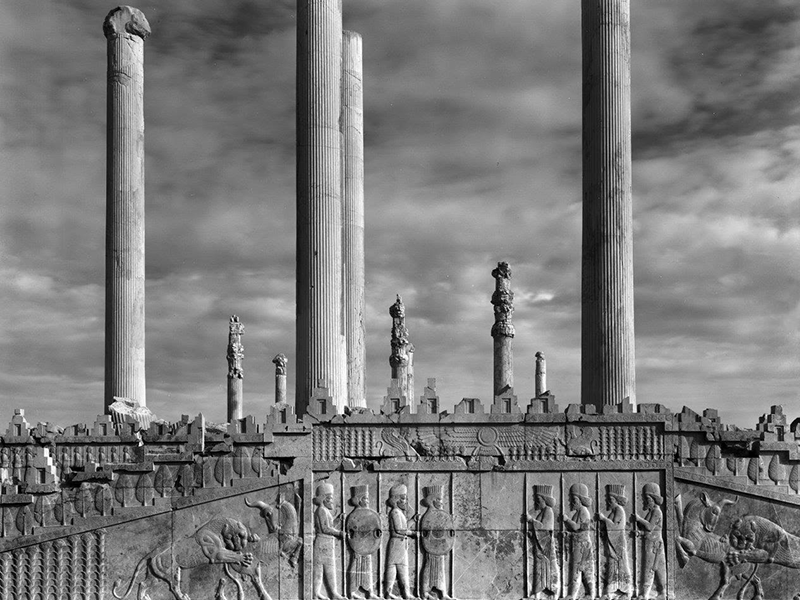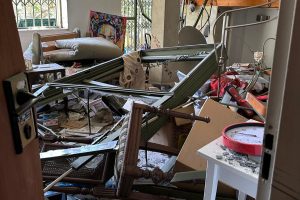The wine and hors d’oeuvres flowed and an oud player strummed Iranian melodies, as well-wishers and art lovers, many of them Iranian expats, gathered at the Liss Gallery, at 112 Cumberland St. in Toronto, for the May 3 opening of The Iran Collection, Simeon Posen’s latest photography show.
While the exhibit may be new, the 23 black and white photos on display were taken more than 40 years ago. All but one of the photos are silver gelatin prints developed by Posen in his dark room.

In 1976, Posen, a professional architect and an accomplished photographer, received a Canada Council grant to photograph the landmarks of Iran.
He shot deserts, mosques, churches, bazaars and the ruins of Persepolis, the city built by Cyrus the Great in the sixth century BCE. “These Iranian buildings are extraordinary,” Posen said. “Persepolis was the spiritual centre of the Persian Empire.”
Posen was able to explore the site quite freely, but today the area is well guarded, to prevent the theft of the antiquities, he said.
After a small exhibition in 1977, the prints and the negatives were shelved. When Posen and his partner, Caryn Levine, were in New York last November, Levine urged him to show his pictures of Iran (they were on a website) to a curator at the Metropolitan Museum of Art (the Met).
READ: VIEWING JEWISH MOROCCO THROUGH ART
“I would not have picked up the phone, had she not encouraged me,” Posen said. “She said the photos were valuable architectural records.”
He approached various departments, and while everyone was trying to be helpful, he got the runaround, he said. But eventually, Tim Healy, the head of the Met’s ancient Near East department, contacted him.

“He was very enthusiastic,” Posen recounted. “He wanted to speak with me right away. He made me feel terrific.… We agreed that these photos would be a gift.”
He gave the Met a set of 24 silver gelatin prints, to be followed by an additional set of 24.
This acquisition by the Met sparked Brian Liss, who has represented Posen since 1998, to mount the current show, which will run until May 20.
“Iran is the cradle of civilization,” Liss said. “This collection conveys its importance.”
All the photos, which were taken before the fall of the shah of Iran, when visitors could travel around the country easily, Posen said. “I always felt safe there.”
One of the photos in the collection is the tomb of Cyrus, he said. “It’s a surprisingly simple monument.”
So why would a Jewish boy want go to Iran? Posen said he had been personally invited by James George, the Canadian ambassador to Iran at the time. He had become friends with Graham George, the ambassador’s son, when the two were students at the Frank Lloyd Wright School of Architecture. It was through this program that Posen had the opportunity to study photography with the late Ansel Adams, the iconic America photographer.
Posen said he has been passionate about photography since he was a child, but he struggled in the darkroom.
He said his printing technique improved dramatically after those classes with Adams back in 1972.
In Iran, all the photography was done with a Kodak Eastman Master View, a camera that used eight by 10-inch film.
Those cameras had been out of production since the mid-1950s, but Posen said he was able to find one in pristine condition from the owner of the photography studio next to his father’s east-end hardware store. “Sometimes things just fall into place.”
To protect the negatives, all the photos were developed in Iran during his two-month stay, Posen said. “I brought my chemicals and all I needed was a bathroom.”
He said his show is stirring a lot of interest among Iranian expats living in Toronto, many of whom left their homeland after the 1979 Iranian Revolution. “The exhibition will be a nice remembrance for them. These are the buildings they grew up with.”
The exhibit runs until May 20.







